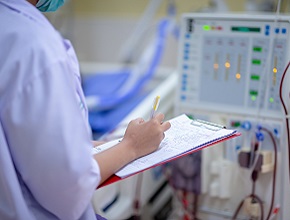Monkeypox infection across 16 countries from April to June 2022
For a McMaster Perspective interview discussing this update, click here.
Background: Monkeypox virus is part of the Orthopoxvirus genus of viruses and is thereby related to variola, which causes smallpox. Until recently infection with monkeypox virus was seldom reported outside of Central and West Africa, where it is endemic. In 2022 there has been a surge in cases worldwide, but transmission, risk factors, clinical presentation, and infection-related outcomes remain not well understood.
Methods: To address this gap in knowledge, a collaborative group of clinicians contributed to an international case series to describe the presentation, clinical course, and outcomes of monkeypox virus infections.
Results: This case series describes 528 cases of infection diagnosed over a 2-month period (April-June 2022) at 43 clinical sites in 16 countries that were confirmed by polymerase chain reaction (PCR) testing.
Overall, 98% of cases (median age, 38 years) were gay or bisexual men, 75% were white, and 41% had HIV infection. Sexual activity was the suspected mode of transmission in 95% of cases.
In terms of clinical presentation, 95% of the individuals had a rash, with 64% having 10 or fewer lesions; 73% had anogenital lesions; and 41% had mucosal lesions. Systemic features preceding the rash included fever (62%), lethargy (41%), myalgia (31%), headache (27%), and lymphadenopathy (56%). Concomitant sexually transmitted infections were reported in 29% (109/377) of persons in whom such testing was done.
In 23 cases with a clear exposure history, the median incubation period was 7 days (range, 3-20). Monkeypox virus DNA was detected in 91% (29/32) of individuals in whom seminal fluid was analyzed.
In terms of treatment and clinical course, 5% of persons received antiviral therapy and 13% were hospitalized. The reasons for hospitalization were pain management (mostly for anorectal pain; n = 21), soft-tissue superinfection (n = 18), pharyngitis that limited oral intake (n = 5), eye lesions (n = 2), acute kidney injury (n = 2), myocarditis (n = 2), and infection-control purposes (n = 13). No deaths were reported.
Conclusions: The study authors concluded that, based on this case series, the clinical presentation of monkeypox is primarily with dermatologic and systemic findings. They also endorsed the need for rapid identification and diagnosis of infection to contain further community spread if cases developed outside of regions where monkeypox has been endemic.
McMaster editors’ commentary: In patients with monkeypox the typical rash is similar in appearance to smallpox, but the mortality rates of monkeypox infection are considerably lower than those of smallpox.
In general, the management of monkeypox infection is supportive, with local measures to relieve pain and inflammation. Antiviral treatment with tecovirimat (TPOXX) is considered in selected patients, including those who are immunocompromised or have severe disease. Other antiviral agents are being evaluated for the treatment of monkeypox infection.
 English
English
 Español
Español
 українська
українська







